Skeleton Woman: Change the way you think about loss
The bone-deep truth about love, letting go, and life after loss
You can also listen to this post on YouTube.
***
She had done something of which her father disapproved, although no one any longer remembered what it was.
Over the cliff, the woman was thrown. Over time, the sea and the rocks and the fish together stripped her of flesh and sinew, leaving only bones. As she lay underwater, Skeleton Woman turned over and over in the currents – cast away, but not forgotten. Not entirely.
One day, a fisherman unknowingly hooked her ribcage while out at sea. Assuming he'd caught a very big fish, he struggled to reel her in, thinking of all the meals he'd provide for his people, only to be horrified when her skeletal form emerged from the water.
But he didn't realise what had happened, exactly. He thought her a ghost or monster born of the sea, and so when he snatched up his gear and fled across the tundra, unwittingly dragging her behind, he was terrified, believing her to be in pursuit. No matter how fast he ran, she followed, bumping along behind his kayak, collecting icicles and frozen fish as she went.
Eventually, he reached his home, where he collapsed in fear and exhaustion. But when he lit his whale oil lamp and saw her twisted bones strewn on the ground, he found himself moved by compassion. So, gently, he began to untangle the Skeleton Woman from his fishing line, murmuring soft words like a lullaby. "Oh, na, na, na."
First he untangled the toes, then the ankles.
"Oh, na, na, na," he sang, on and on.
The fisherman worked into the night until, after dressing her in furs to keep her warm, Skeleton Woman's bones were all in the order a human's should be.
Now, as he oiled the precious wood of his fishing rod and rewound the gut, he gazed over at Skeleton Woman from time to time, the light of the fire flickering across her form. Eventually, the man fell asleep. As he dreamed, for reasons we don't know, a single tear fell from his eye. Seeing this, Skeleton Woman became suddenly aware of the extreme thirst that was upon her. She dragged her bones across the ground, put her mouth to his cheek and drank.
That tear became a river, so she drank and she drank and she drank. She then reached into his chest to take out the drum of his heart, which she beat to a reviving, soul-arousing rhythm. Bom, Bomm! … Bom, Bomm!
Singing now, Skeleton Woman sang the flesh back onto her body: she sang for hair, and keen eyes, and nice strong hands; she sang for breasts, and legs, and everything a woman needs to be whole.
When she was done, she sang the sleeping man's clothes off and crept into bed with him, where she replaced his heart and entangled her body with his – tangled in a good way now – skin to skin.
The story goes that she and the fisherman went away together and were forever well-fed by the creatures she'd known underwater. At least, the people say that this is true, and that is all they know.
Bone-deep truth
"This story reminds us that true beauty is revealed only when we stop wishing for ugliness to disappear and accept the other for what he or she -or place-is."
– Trebbe Johnson, Lessons from Skeleton Woman: Radical Joy Revealed
This is the tale of Skeleton Woman, a story based on an Inuit poem, told by Clarissa Pinkola Estes in Women Who Run with the Wolves, and paraphrased here for brevity.
I'm telling you this story because it is beautiful and because it is a most potent symbolic map for the ever-present Life/Death/Life cycle that spins and spins through nature, through love and relationships, the process of personal growth, and through each of us as well.
The challenges of living in a death-averse world
In our culture, we are taught to cling to the “life” side of the cycle: to growth, beauty, vitality, certainty, progress. We fight to keep the “light” on, even as the flame gutters.
But here’s the thing: the moment we resist the death side of life — loss, endings, stillness, grief — we also resist the fullness of love, of wholeness, of meaning itself, as well as the opportunity to transform, or to be reborn, as something new, more vital and more connected.
Death in other cultures
This isn't the case in all cultures. In Bhutan, there's a belief that thinking about death five times a day will make you happy. In Thailand, Buddhist Monks have been known to meditate to photos of rotting corpses as a reminder of their own mortality. In the practice of traditional native healing or shamanism, Estés writes, Lady Death is said to turn the baby in the womb to the head-down position so it can be born.
Life is death, and death is life. Because to love is to risk loss. To create is to accept eventual destruction. To truly live is to die a little over and over again, each time reforming anew. Wiser. Greater. More whole.
The meaning of Skeleton Woman
The story of Skeleton Woman reminds us that we can’t just chase the catch; we must also meet the bones. We need to tend to the tangled, terrifying parts of ourselves, and offer them a seat by the fire. The new life both Skeleton Woman and the fisherman wound up enjoying (pun intended) was only made possible because he got over his fear, stopped running, and let himself see her as she was.
This isn’t just about shadow work or grief processing, though it can look like those things. It’s about learning to sit with the old as well as the new; the crone as well as the maiden. It's to welcome not only birth and expansion, but also decay and descent, as equally important and equally nurturing parts of the experience of life.
Welcoming Death and Endings
So, what if we were to see death not as something that ends things, but reveals them? The Life/Death/Life cycle issues clarity – it feeds a particular type of wisdom that can only be earned through surrender.
And yet… Most of us spend our lives trying to stay forever in the “spring” of being. As if we can outsmart entropy. As if darkness is a flaw to fix rather than a chapter to honour.
So, the lesson to be taken from Skeleton Woman's story is simple, if not easy or painless. It's this:
If you want more life, you must befriend death.
If you want growth and new beginnings, you must embrace decay, loss and inevitable endings.
It hurts, doesn't it? Even just to think about it. And that's the point. If life is death and death is life, then pleasure is pain and pain is pleasure. Love is loss and loss is love. These things are one and the same: they cannot be split, and the harder we try to divide them, the less we get of the side we believe we want.
So, whatever this means for you, I'm asking you to give yourself a gentle permission now to let things go.
Let relationships shed their old skins.
Let identities dissolve so new ones can emerge.
Let love mean loss.
Let epiphany mean doubt.
Let beginnings form from endings.
Because what we grieve, we have loved.
And what we allow ourselves to relinquish makes space for the new life that comes next.
So, the next time life brings you to your knees, or strips you bare, or hauls up something skeletal from the depths, don’t run. Light a lamp. Sit beside the bones. You might just find they’re yours — and that they have been waiting all along, ready now to be sung back to life.
—
References:
Skeleton Woman, Inuit folklore
Clarissa Pinkola Estés, ‘Women Who Run With the Wolves’
Trebbe Johnson, ‘Lessons from Skeleton Woman: Radical Joy Revealed’
K. M. Weiland, ‘Writing Archetypal Character Arcs’
We’re Hazel (ex boxer, therapist and author) and Ellie (ex psychology science writer). We left our jobs to build an interactive narrative app for self-awareness and emotion regulation (Betwixt), which you can try on Android here and on iOS here.



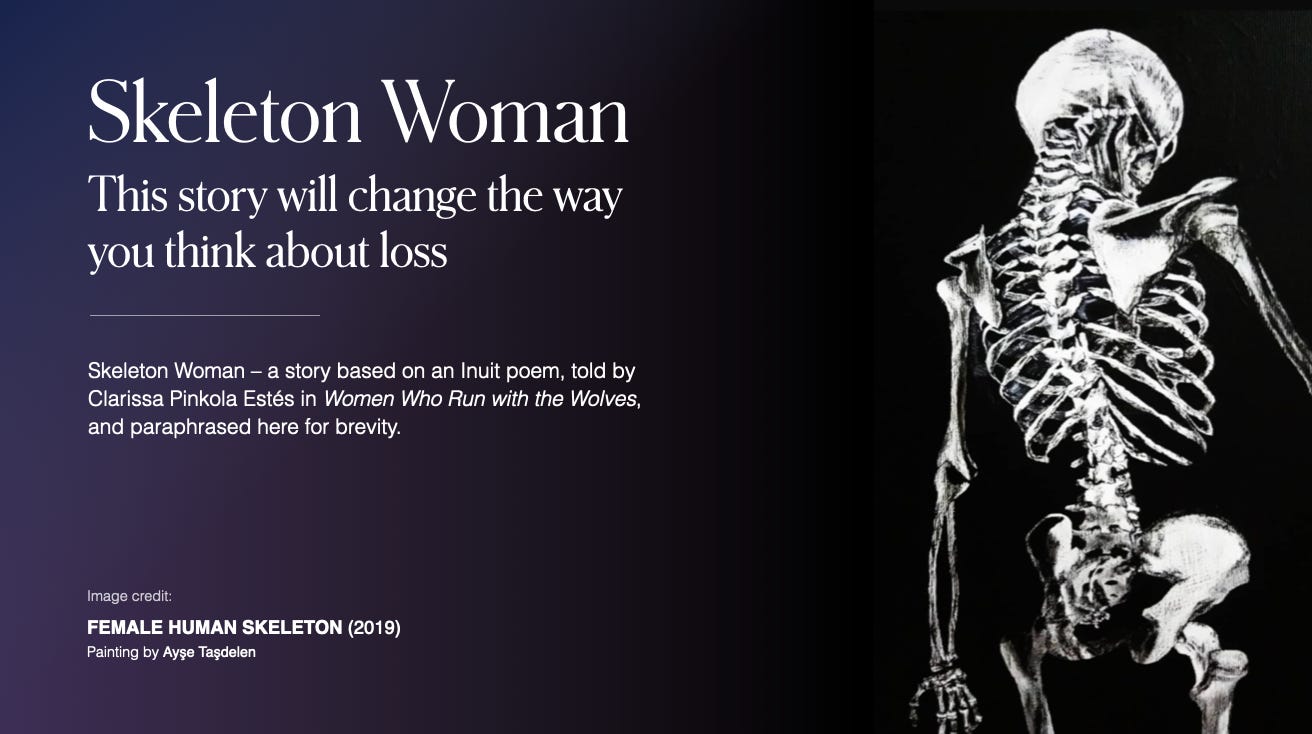


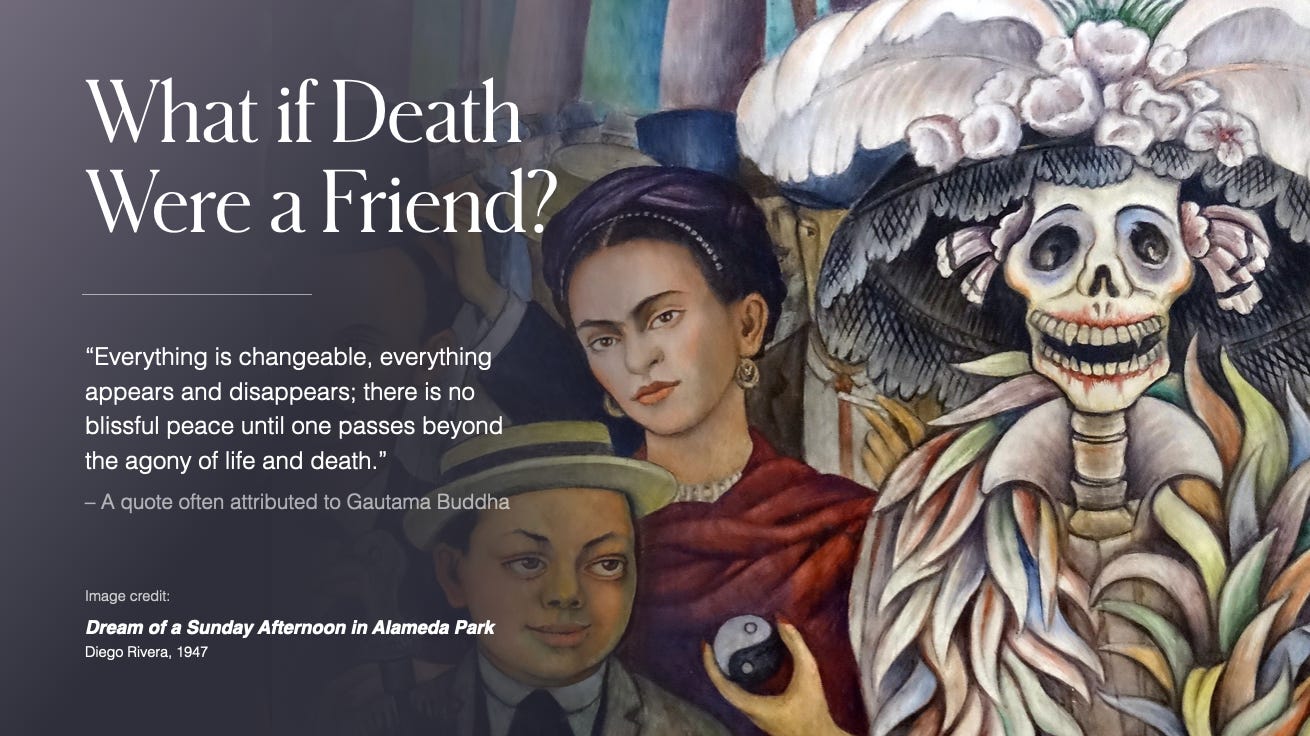
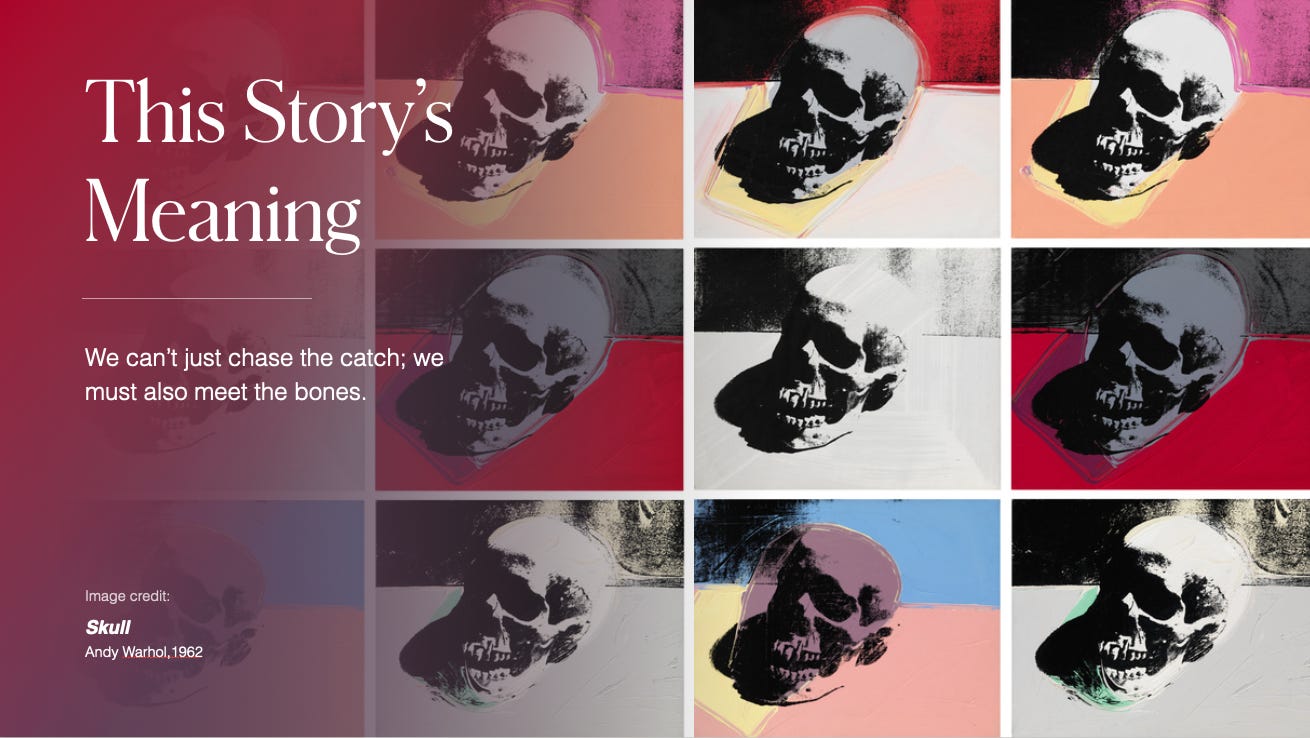
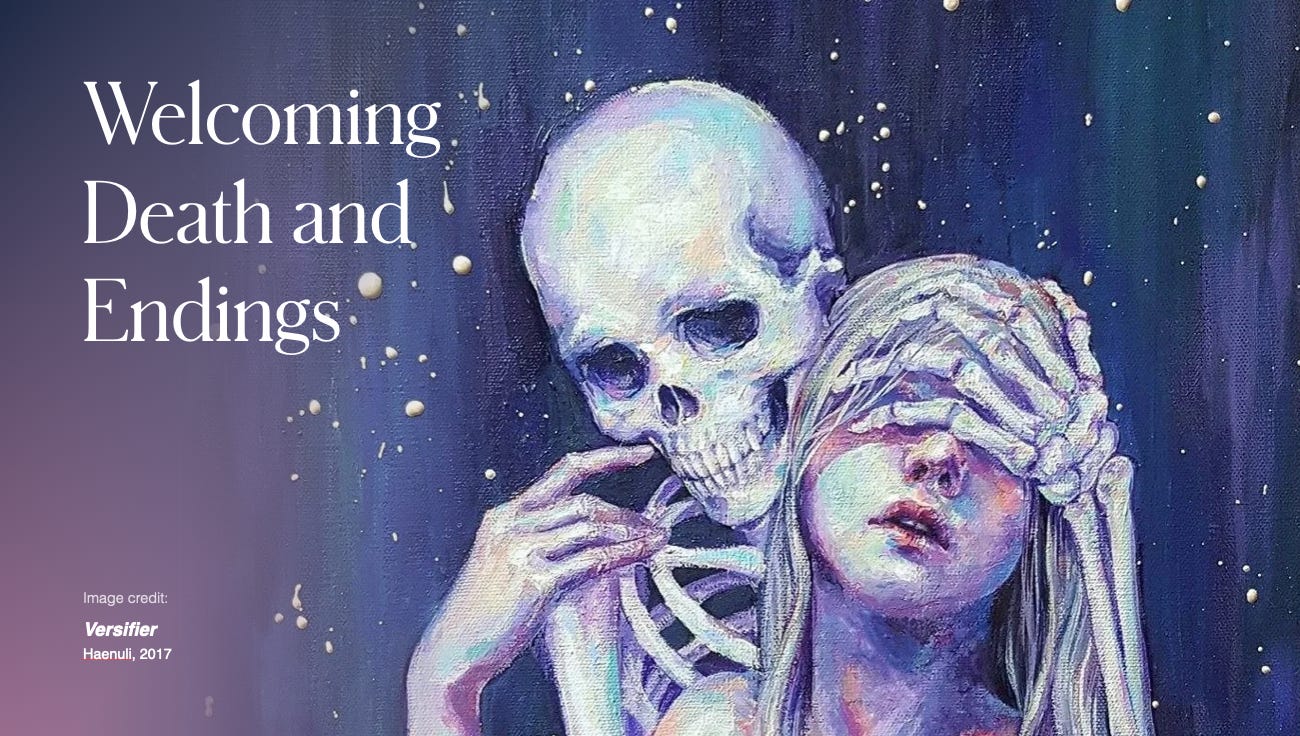

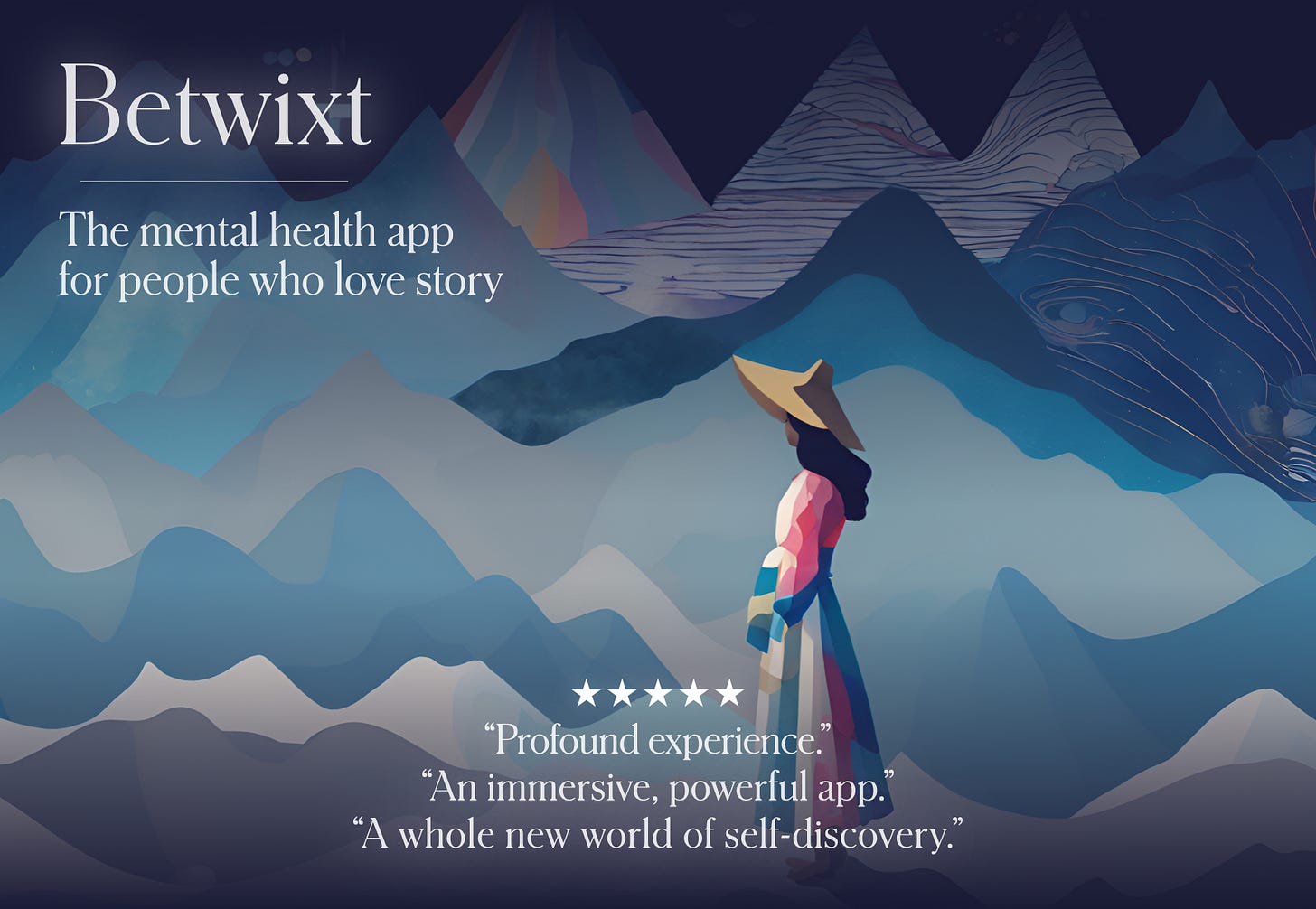
An amazing story that took me to another time and place when I first heard Dr.Estes tell it. Betwixt is an incredible app and has the ability to move your mind as well. I am grateful for the good service you are doing with this project and technology. Thank you.
Death and grief and loss is the greatest portal to Living